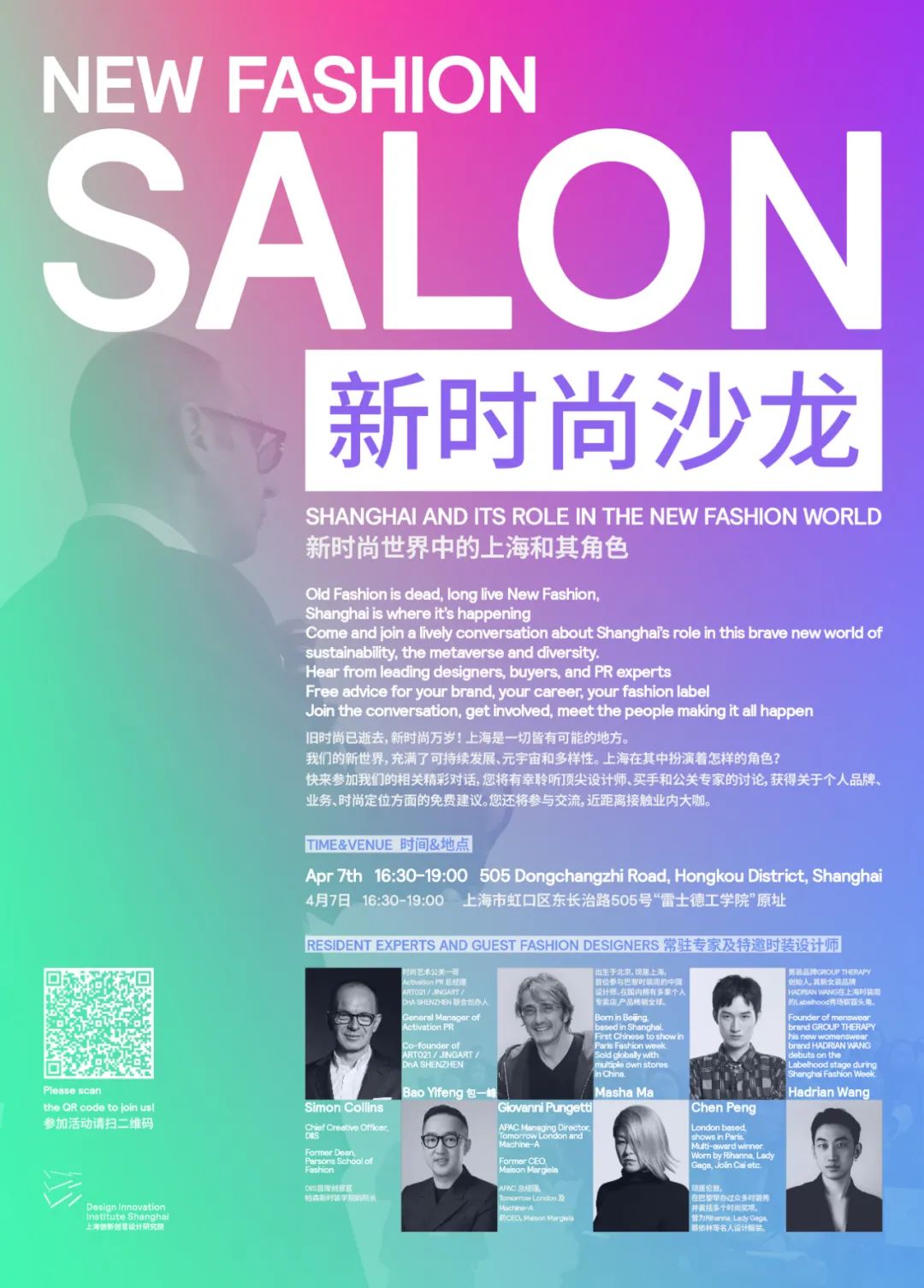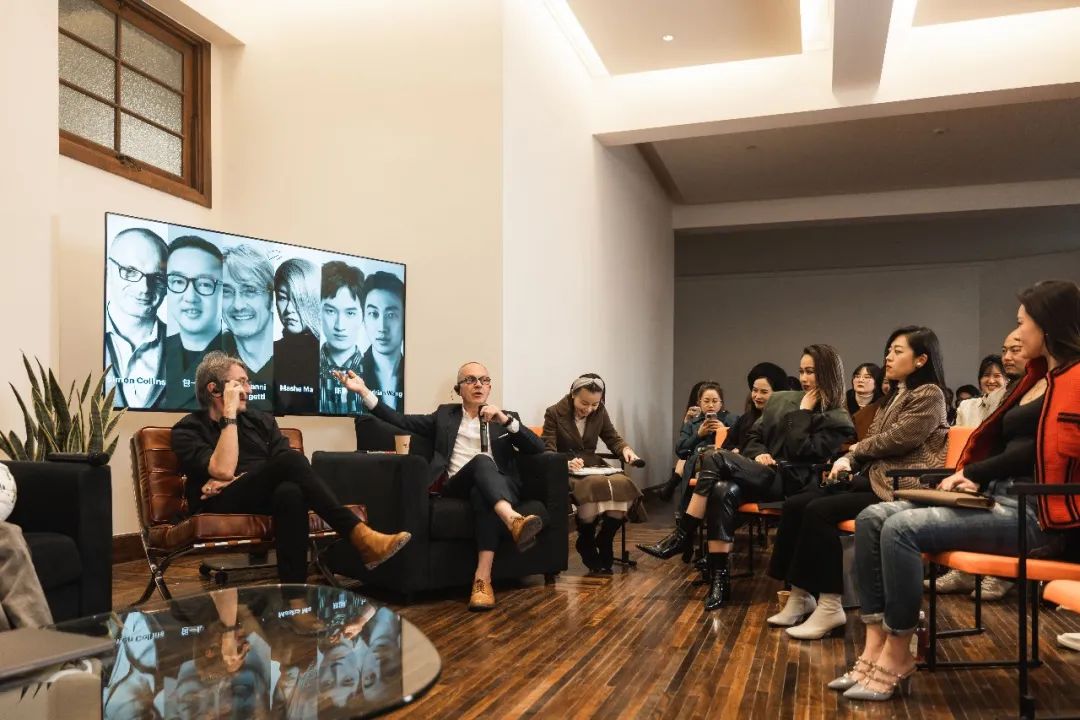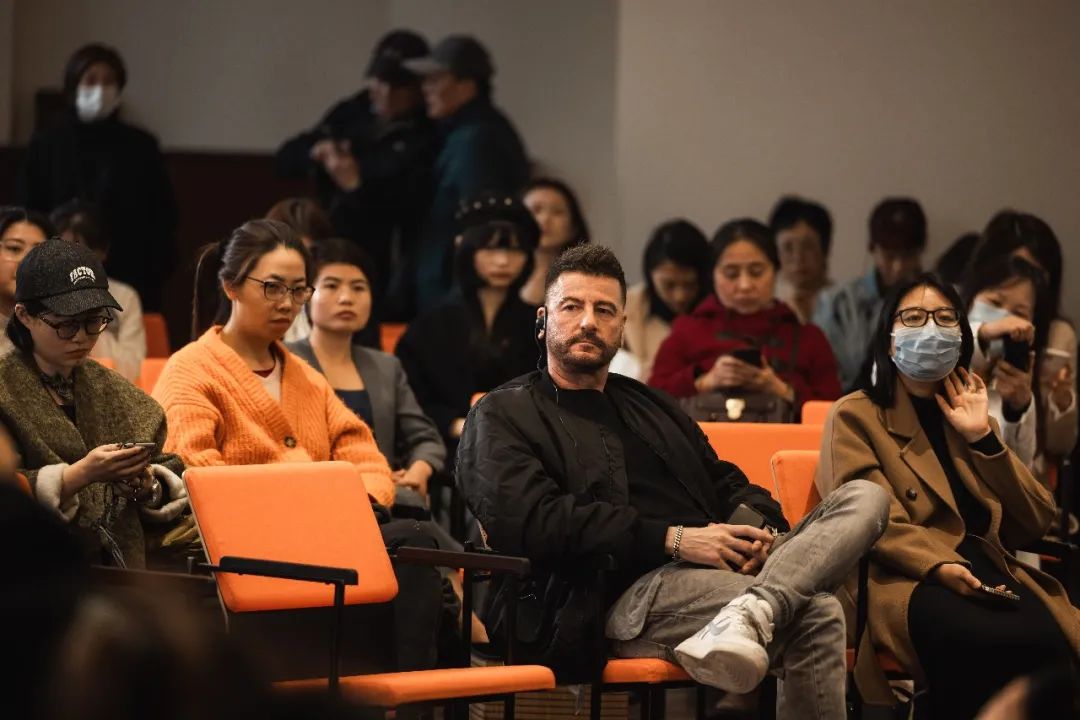新时尚世界中的上海和其角色
SHANGHAI AND ITS ROLE
IN THE NEW FASHION WORLD

4月7号晚,我们如期举办的新时尚沙龙在灵感碰撞和愉悦的交谈氛围中完美落下句点。葡萄美酒环保纸杯,时尚发展云游未来……这次活动的初衷旨在创造,聚集和激活现下时尚行业的生态系统。来自国内外的业界大咖,众多国内的时尚品牌创始人,还有来自我们社区的时尚人士们共聚一堂,探讨现下的时尚发展和未来的可能性。
On April 7th, our New Fashion Salon was held here in DIIS to bring innovation and ideas to the current fashion industry. We gathered international fashion icons and industrial leaders, founders of domestic fashion brands, and fashionistas from our community together to discuss the current fashion development and future possibilities.

Guests
Simon Collins (Moderator)
Bao YiFeng 包一峰
Giovanni Pungetti
Masha Ma
Chen Peng 陈鹏

△摄影:陈解勇
上海包含了很多时尚之都的风格,海纳百川,它的包容性给予了这里的时尚发展很多的空间。沙龙的讨论围绕着什么才是中国化的设计语汇展开……
Shanghai integrates styles from all other fashion cities, and its inclusiveness provides for a rapid changing of fashion development. The discussion of the salon started with what represents Chinese design.

△摄影:芮
在上海的设计师们似乎没有这样的困扰,就是如何在自己的设计中力证中国元素。曾经一个国家级的媒体采访玛莎,问:“你的设计中为什么没有“龙”和“凤”?”
Designers in Shanghai don't seem to have such a problem with how to show Chinese elements in their designs.
Masha:
那个时候还很早,也许很多设计师都需要一个符号化的元素去象征性的,直观的,简单偏粗旷的方式去体现你是谁。其实日本的那一代的设计师做到了文化上重新的去见证和自我表达。我们反观日本设计师没有这个困扰,就是说一定要在自己的设计中证明日本的文化以及来自日本的设计这样一个事实。其实只要你走出国门,你能弄明白什么是当代的中国,你所处的文化角度非常重要,你的(设计的)语境语言也会变得清晰。
Masha:
It was very early at the time, maybe many designers needed a symbolic element to explain who they are in a direct, intuitive way. In fact, the Japanese designers of that generation did well in self-expression. On the contrary, Japanese designers do not have this problem, which is to prove the Japanese culture and where they come from in their own designs. In fact, as you get to the global market, you need to understand what is contemporary China and that the cultural perspective is very important. Then the context of your design language will become clear.

△摄影:芮
Giovanni:
我发现国内的大环境就是设计师们都特别热衷于在自己的设计中体现中国元素,就是都有这样的一种执念,但是他们忽略了一点,你的设计本身就已经自带中国元素,因为你们的背景,而无需反复去在设计中强调这一点。如果你想要走出中国市场,你更无需去证明什么是中国化的设计。
Giovanni:
I find in general, Chinese designers are particularly keen to reflect Chinese culture in their designs. But they miss the point that their design already comes with Chinese elements because of their background, so there is no need to repeatedly emphasize it in their design. If they want to go beyond the Chinese market, they don't need to prove what Chinese design is.

△摄影:芮
主持人Simon问Masha Ma和Chen Peng:
你们有阵子都生活在国外,那伦敦和巴黎的行业是怎样以一个中国设计师身份去看待你们的?
Host Simon asked Masha Ma and Chen Peng:
You've been living abroad for a while, how do the London and Paris fashion industries receive you as a Chinese designer?
Peng:
我们面临的问题是,当时在伦敦学习的时候会经常被问起我们国家的符号是什么?或是如何在作品当中去表现我们的文化背景?我认为在我们这一代不是特别需要去讲述我们的元素和文化,就像我是来自一个很传统的中国城市景德镇,我不需要刻意把青花瓷元素放到我的作品里去印证我来自那里。相反越是想要证明我们的文化元素越是说明我们在文化上缺乏一定的自信程度。我们要做的就是去自然表达出我们的一种生活状态,把我自己日常中感兴趣的点展现在我的设计里,而不是说我的文化背景和我们民族的元素。
Peng:
The problem we faced was that when we were studying in London, we were often asked what the symbols of our country were. Or how to express our cultural background in our work. I think in our generation we don't particularly need to talk about our elements and culture. Fort example I am from Jingdezhen, a very traditional Chinese city, but I don't need to deliberately put blue and white porcelain elements into my work to prove that I am from there. On the contrary, the more we try to prove our cultural elements, the more we lack a certain degree of confidence in our culture. In my design work I express my culture naturally to show the points that interest me in my daily life, not to prove my cultural background.

△摄影:芮
Simon:
作为一个中国设计师如何在上海这个舞台展现自己?你们在创作的时候会去思考怎样面对国内市场?怎样彰显传统文化?怎样融入国际市场?
Simon:
As a Chinese designer, how do you present yourself on the Shanghai stage? Do you think about how to appeal to the domestic market when you create? How to show the traditional culture? Or how to integrate into the international market?

△摄影:芮
Hadrian:
其实我在做第一季男装的时候用过一丢丢的中国元素作为开头。而在美国上学的时候也没有面对过这个问题,没有人会去主张在作品中加入文化元素。就好比我这次女装发布,灵感完全是来自18世纪的一个法国外交官,我在他身上找到了一种身份的认同感。关于我对传统中国文化的看法,我认为它是一种含蓄的美,而我们从小到大在这里耳目渲染的文化功底足以表达我们的文化性。
Hadrian:
I actually used Chinese elements as a starting point when I did the first season of menswear. And I didn't face this problem when I was going to school in the U.S. No one would advocate for adding cultural elements to the work. It's like my womenswear release, which was totally inspired by a French diplomat in the 18th century, in whom I found a sense of identity. Regarding my view of traditional Chinese culture, I think it is a kind of subtle beauty. The cultural influence that we experience since childhood is enough to express our culture.

△摄影:芮
Simon:
希望在坐的设计师们能明白我们真的无需在设计中去力证我们的传统文化和我们的中国元素。那我们接下来想了解,在这里我们能做什么和文化艺术产业相关的为上海赋能?
Simon:
I hope the designers here will understand that we really don't need to prove our traditional culture and our Chinese elements in our design. Then we want to know what we can do here to empower Shanghai in relation to the arts and culture industry?
Yifeng:
上海时装周真正的名字是上海国际时装文化节,以前都是由国际设计师把他们最前沿的设计带来上海展出,但现在这两年,上海的城市设施,展示陈列窗口已经发展成比其他时尚之都更有活力的场域,更适合年轻设计师作为长线发展的一个地方。因为不单单是很多有潜力的民间时尚机构像LabelHood,OnTimeShow在积极响应,就连政府也为上海时装周搭台出力,纺织产业协会从中默默支持。很多国外的设计师选择来上海时装周发布新秀,国外的展示橱窗也来此订货,国内外新兴品牌入驻众多大规模百货商场,时尚街区,买手店等,足以见到全球对上海市场的认可和对这个新时尚平台的看好。尤其这里还有像上海创新创意设计研究院这样的机构通过这样的活动为上海这座城市的设计时尚领域发展赋能,也正因如此,我们才有机会坐在这里和全球时尚界,设计界前辈们交流学习,为上海新时尚赋能。
Yifeng:
The real name of Shanghai Fashion Week is Shanghai International Fashion Culture Festival. It used to be a place where international designers brought their cutting-edge designs to Shanghai for display. But now in the past two years Shanghai has developed into a more dynamic venue than other fashion capitals, more suitable for young designers for long-term development.
Because not only many potential private fashion institutions such as LabelHood and OnTimeShow are responding positively, but also the government has made efforts to set the stage for Shanghai Fashion Week, and the Textile Industry Association is supporting it. Many foreign designers choose to come to Shanghai Fashion Week to launch their new shows. Foreign buyers also come here to order. Domestic and foreign emerging brands can be found in many large-scale department stores, fashion neighborhoods, buying stores, etc. This shows the global recognition of the Shanghai market and the optimism of this new fashion platform. Right here in the Design Innovation Institute Shanghai we are empowering the development of design and fashion in Shanghai. Because of events like this we have the opportunity to learn from the global fashion and design industry seniors to empower Shanghai's new fashion.

△摄影:芮
Simon:
那我们应该更加努力搬砖!(观众笑)Giovanni,Tomorrow 是一个国际时尚平台,来自伦敦,代理了很多全球时尚品牌的同时也在孵化一些很有潜能的新兴潮牌。作为这个平台的亚太区负责人,你觉得应该为上海做些什么?
Simon:
Then we should work harder at DIIS! (Audience laugh) Giovanni, Tomorrow is an international fashion platform from London that represents many global fashion brands and is also incubating some very promising emerging hip brands. As the head of the platform in Asia Pacific, what do you think you should do for Shanghai?
Giovanni:
我赞同小包所说的有关于上海时装周已经在国际上炙手可热,现在疫情终于结束,中国打开国门,希望上海时装周不单单是只把最顶尖的奢侈品牌展示到国内市场,通过上海时装周的兴起我们也能将众多外国设计师,设计品牌展示给国内市场;通过和上海时尚组织机构合作,去做时尚交流,设计文化交换,做到真正连接中国和世界的桥梁。只有当我们架起这座桥梁,世界才能对中国时尚设计文化有更全面的认识和了解。
Giovanni:
I agree with what Xiao Bao that Shanghai Fashion Week is already hot in the international arena. Now that the epidemic is finally over and China has opened its doors, I hope that Shanghai Fashion Week will showcase the top luxury brands to the domestic market. Through the rise of Shanghai Fashion Week we can also showcase many foreign designers and design brands to the domestic market through cooperation with Shanghai fashion organizations. To do fashion, design, and cultural exchange, and to achieve a real bridge between China and the world. Through this bridge the world can have a more comprehensive understanding of Chinese fashion and design culture.
Simon:
Hadrian作为中国设计师,你觉得上海(时装周/时尚发展)还可以怎样做的更好?
Simon:
Hadrian, as a Chinese designer, what do you think Shanghai Fashion Week and Fashion Development can do better?
Hadrian:
对我们新兴设计师来说,Giovanni希望能建起的这座桥梁对我们本土设计师走向国际舞台也具有更加实际的意义和优势。
Hadrian:
For us emerging designers, the bridge that Giovanni hopes to build has more practical implications and advantages for our local designers to go international as well.
观众之音
Voices from the audience

△摄影:芮
/1
我来自纺织行业。在座的设计师们,如何为中国的纺织、面料设计领域做出联系和贡献?
I come from the textile industry, how can you as designers help to make some connections and contributions to the textile, fabric design side of China?
Peng:
首先我们品牌所用的材料百分百是来自中国的,通过设计制成精美成衣,销往全球。问题在于很多设计师订单的体量不足以找到大型的(布料)研发属性的企业去配合他们完成这样一个高价格高开发成本的材料。中国的纺织品,面料在国际上能达到中等偏上的水平,大多数纺织企业是生产快消时尚所需的能够出口全球的面料,相对我们自主品牌来说,没有更好的氛围去支持我们的需求。但像现在这两年,有些做得很好像是杭州的面料图书馆,就能给到我们甚至国际设计师一些比较好的支持。
Peng:
First of all, 100% of the materials used by our brand are from China. They are designed to be made into beautiful ready-to-wear and sold worldwide. However one problem is that the volume of many young designer orders is not big enough for a large fabric company to cooperate with them. Chinese fabrics are good enough for the middle to upper level in the international arena. Many Chinese textile companies are producing fabrics for global mass market fashion. There is some support for smaller brands like us, for example the fabric library in Hangzhou, but it would be good if they can give domestic and international designers better support.
Masha:
这个问题很好,不仅对于纺织行业底层员工来说还是整个中国纺织行业的下滑都息息相关。这回到我们刚刚所说的,品牌需不需要东方语言的问题。如果你作为一个设计师,不需要考虑这个问题;如果你是做一个设计品牌,那需要少考虑这个问题;但如果你想成为一个全世界卓越的品牌,你需要解决这个问题。无论是从创意,面料,生产,宣发,零售,每一个端口你都需要解决这个问题。文化自信不是自己给自己的,它是要从别人的认可中而来。陈鹏说的没错,有研发能力的端口是无法在小企业上多次快法试错的,但今年有很多新的动态出现,设计师也要想办法开发新的销路平台的可能性,尽量满足面料厂端口的起订量。面料端口也尽量去把单价降低,双方共同努力,才可能通过直播或者别的通道共同生存下去。之前有一个知名意大利面料商来找我,一个给很多国际奢侈品牌供货的面料商经过疫情三年做出很多变化,尝试了很多他们从未尝试的面料风格,甚至在供货时间上也做出了巨大改变。国内的纺织企业自己也要在面料设计上投入更多的精力和心思去创新,这样对国内的设计师也是一种启发和推动。
Masha:
That's a good question, not only for the bottom of the textile industry but also for the decline of the entire Chinese textile industry. It goes back to what we just said, the question of whether a brand needs an oriental language or not. If you are a designer, you don't need to think about it; if you are a design brand, you need to think less about it; but if you want to be a brand of excellence worldwide, you need to solve this problem. Whether from creativity, fabric, production, promotion, retail, every aspect you need to solve this problem. Cultural confidence is not something you give yourself; it comes from the recognition of others. Chen Peng is right, the textile maker with R & D capability cannot do trial and error with small brands. But this year many new dynamics emerge, designers also need to find ways to develop the possibility of new sales platform, to try to meet the quantities required for domestic fabric makers. Fabric makers also need to work on the unit price reduction. With both sides working together it is possible to succeed with multiple channels. Recently a well-known Italian fabric merchant came to me, they are a fabric supplier to many international luxury brands. After the three year epidemic they made a lot of changes, they tried a lot of ne fabric styles they have never tried, even on the supply chain side they made a huge change. Domestic textile enterprises should also put more energy and thought into innovation. This is also a kind of inspiration and promotion for domestic designers.

△摄影:芮
/2
Giovanni你在上海开设了很高端的买手店,店里有中国设计师品牌吗?如果有,什么让你决定选择了他们?如果没有,那他们需要做些什么从而能被你选中?
Giovanni you have opened a very high-end buyer’s store in Shanghai, do you have any Chinese designer brands in the store? If so, what made you decide to choose them? If not, what do they need to do to be chosen?
Giovanni:
是的,我们有一部分中国的设计师品牌,这也是买手们做的决定。当我们挑选中国品牌的时候,和挑选任何其他品牌的准则一样,需要有国际化的视野。对我们来说,最重要的是他们的设计创新是不是和我们的品牌定位相符,而不是盲目的对于某个文化的痴迷。当然还有新潮度,价格,系列,销售这些因素。最后我们欢迎各地年轻新锐的设计品牌加入,才华是没有国界的。
Giovanni:
Yes, we have a selection of Chinese designer brands, and it's a decision made by the buyers. When we select Chinese brands, they use the same guidelines as for any other brand, an international vision is needed. For us, the most important thing is whether the design innovation is in line with our brand positioning. It’s never a blind obsession with a certain culture. Of course, there are also factors such as trendiness, price, collection, and sales. Finally, we welcome young and emerging design brands from all over the world to join us. True talent has no borders.
/3
问设计师 - 光靠线下推广无法生存,自主设计师怎样去平衡线上直播对品牌的影响?
Designer - How can independent designers balance the impact of online promoting of their brands when offline promotion alone cannot survive?
Hadrian:
直播对品牌来说是一个渠道,能给品牌创造更多效益,接触到更多受众群。在直播前和平台还有播主间谈好利比分配,不能自降品牌价值。
Hadrian:
Live streaming is a channel for brands to create more benefits and reach a larger audience. Before the live broadcast and the platform and broadcasters to talk about the distribution of profit ratio, not to reduce the value of the brand.
/4
问包老师 - 传统媒体和新媒体之间怎样用不同方式去做品牌推广?
Bao YiFeng - How to do brand promotion in different ways between traditional media and new media?
Yifeng:
我要看整个品牌的定位,奢侈品做直播的时候还是以品牌的思路在做策略推广,而非销量。从公关的角度出发,还是希望在品牌建成完善后,再来考虑直播是否能为品牌赋能。有时候要结合品牌自己的供应链能力来回答这个问题,在直播前,评估供应能力,不打没有准备的仗。明星带货不一定适合每个品牌,说不定还会成为品牌的“定时炸弹”。
Yifeng:
I have to look at the positioning of the whole brand. Luxury goods doing live streaming are still doing strategic promotion with the idea of branding, not sales. From the perspective of PR, after the brand is built and perfected, then consider whether live streaming can empower the brand. Sometimes it is necessary to combine the brand's own supply chain capabilities to answer this question, before the live broadcast, to assess the supply capacity, not to fight unprepared battles. Having a Star promote your product on Livestream may not be suitable for every brand. This may become the brand's "time bomb".

△摄影:芮
/5
当名人开始穿你的设计的时候,对你产生了怎样的影响?
When celebrities started wearing your brand, what kind of impact did it have on you?
Peng:
明星效应可以刺激短期销售,长期来说还是品牌的DNA是什么对设计师来说比较重要。
Peng:
he celebrity effect can stimulate short-term sales, but in the long run it’s more important for designers to understand what is their brand DNA.
Giovanni:
客观的说,国内的市场太过于依赖网红和明星的流量,品牌要往长远打算,不能只看眼前利益,想要经久不衰,必须要发展自己的品牌调性。
Giovanni:
Objectively speaking, Chinese market is too obsessed with KOLs and celebrities. Brands should plan for the long term and not just look at the immediate benefits, and they must develop their own brand identity if they want to last.

△摄影:芮
/6
在坐嘉宾对于元宇宙的虚拟时尚有什么看法?
What do our speakers think about virtual fashion in the metaverse?
Simon:
虚拟时尚不能称之为时尚,它无法取代真正的时尚行业,你可以在虚拟世界做时尚之王但现实中仍旧看起来一团糟。虚拟时尚可以是展示时尚的一种工具,但是也仅仅局限于工具而已。
Simon:
Virtual fashion shouldn't be called fashion. It can't replace the real fashion industry. You can be the king of fashion in the virtual world, but still look like a mess in reality. Virtual fashion can be a tool to showcase fashion, but it's only a tool.

△摄影:芮
天色已深,雷士德工学院旧址内光线交叠,新时尚沙龙在全场热闹的社交互动中拉下帷幕……我们希望在上海创新创意设计研究院举办的这场活动能为上海以及中国的时尚发展做出实质以及有意义的贡献。
After two hours of spirited conversation and information sharing the New Fashion Salon came to a close with wine and personal introductions. The audience stayed till the sun went down and the lights came on. This New Fashion Salon at DIIS will make a substantial and meaningful contribution to the development of new fashion in Shanghai and China. The next one is being planned for May.


△摄影:陈解勇

欢迎观看活动直播回放
Free to access the live playback!



